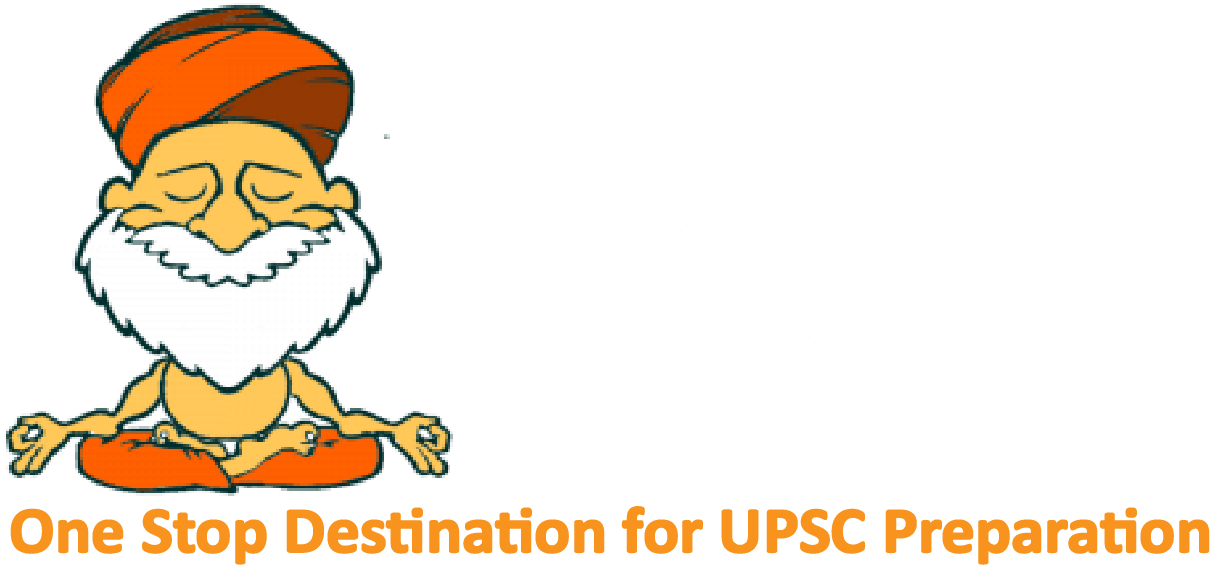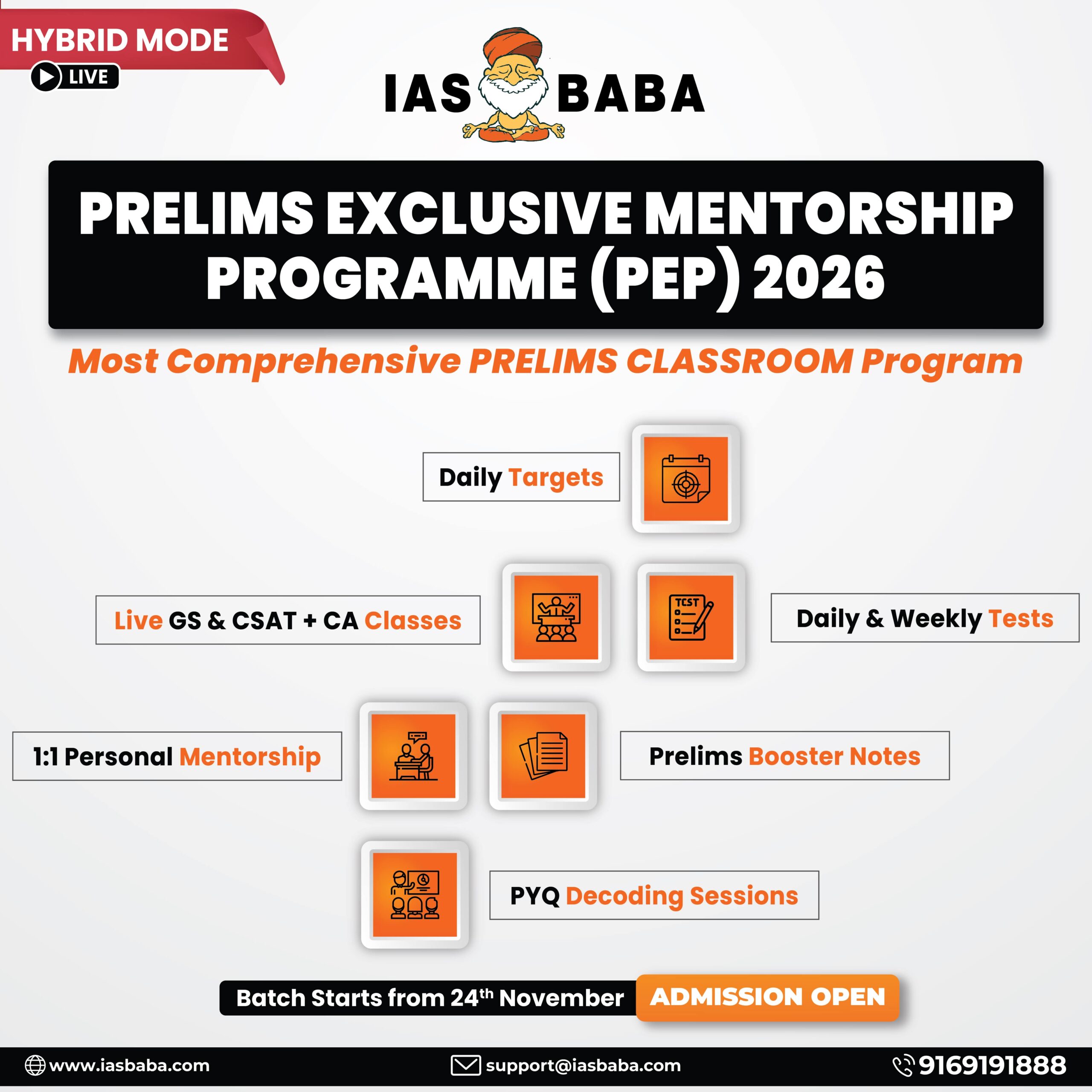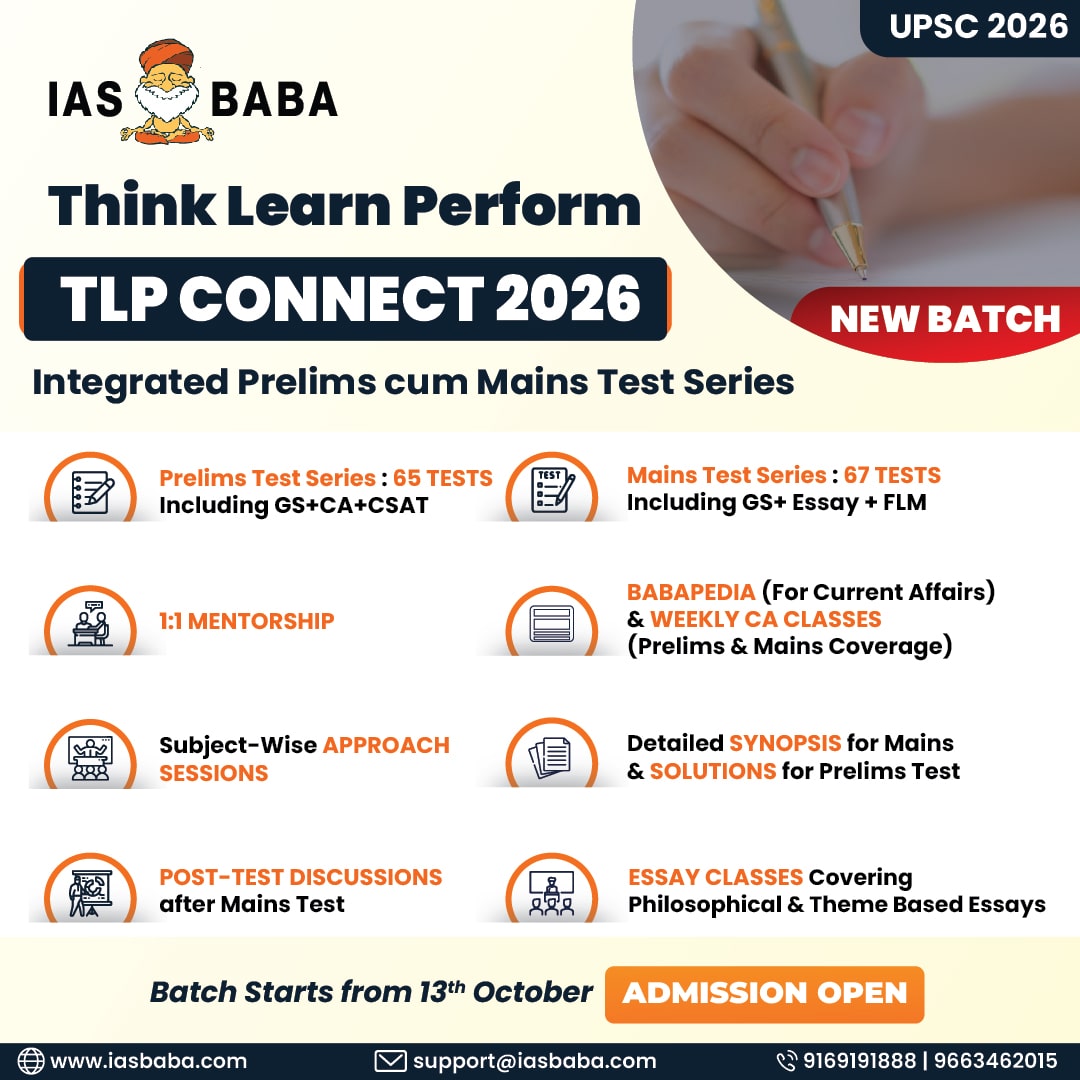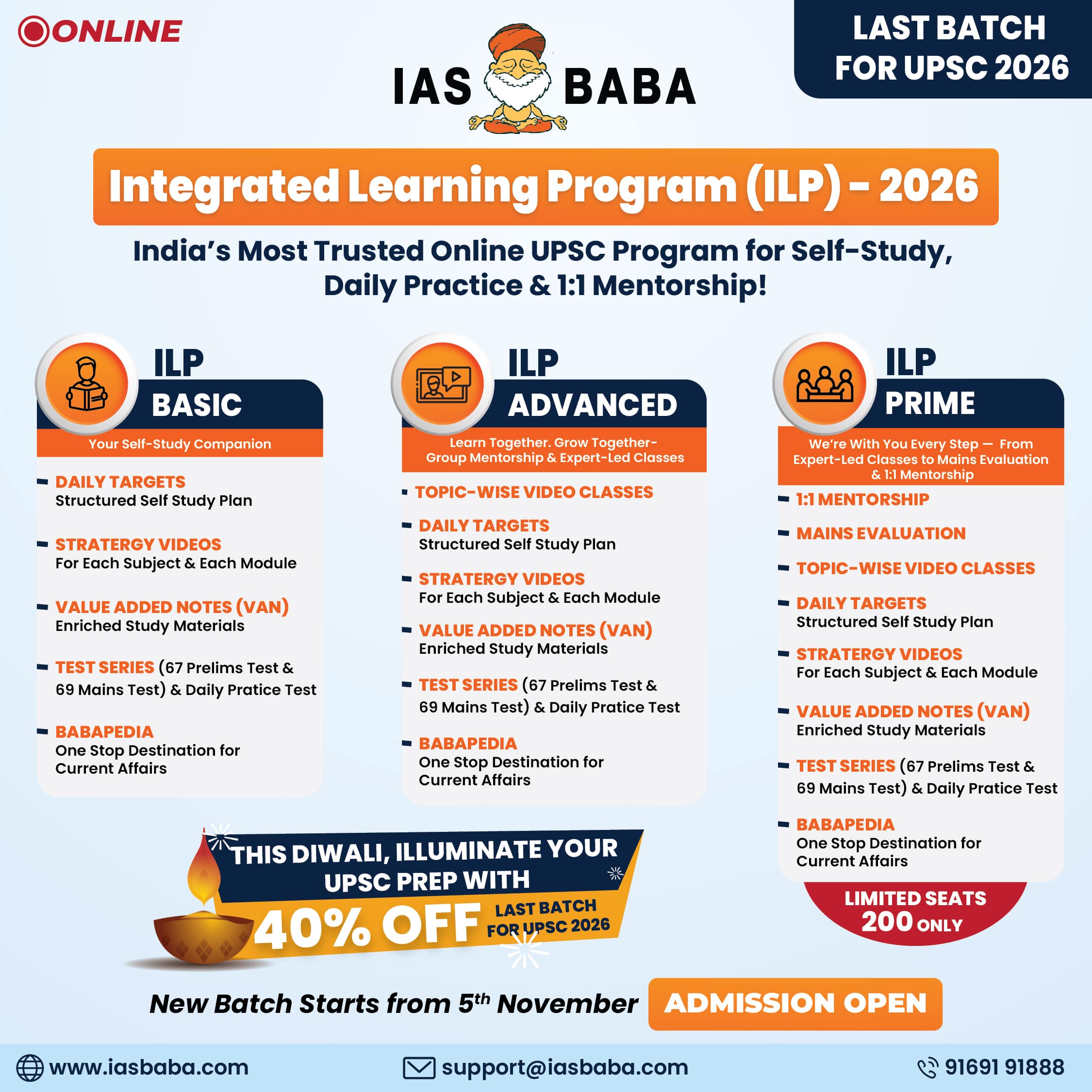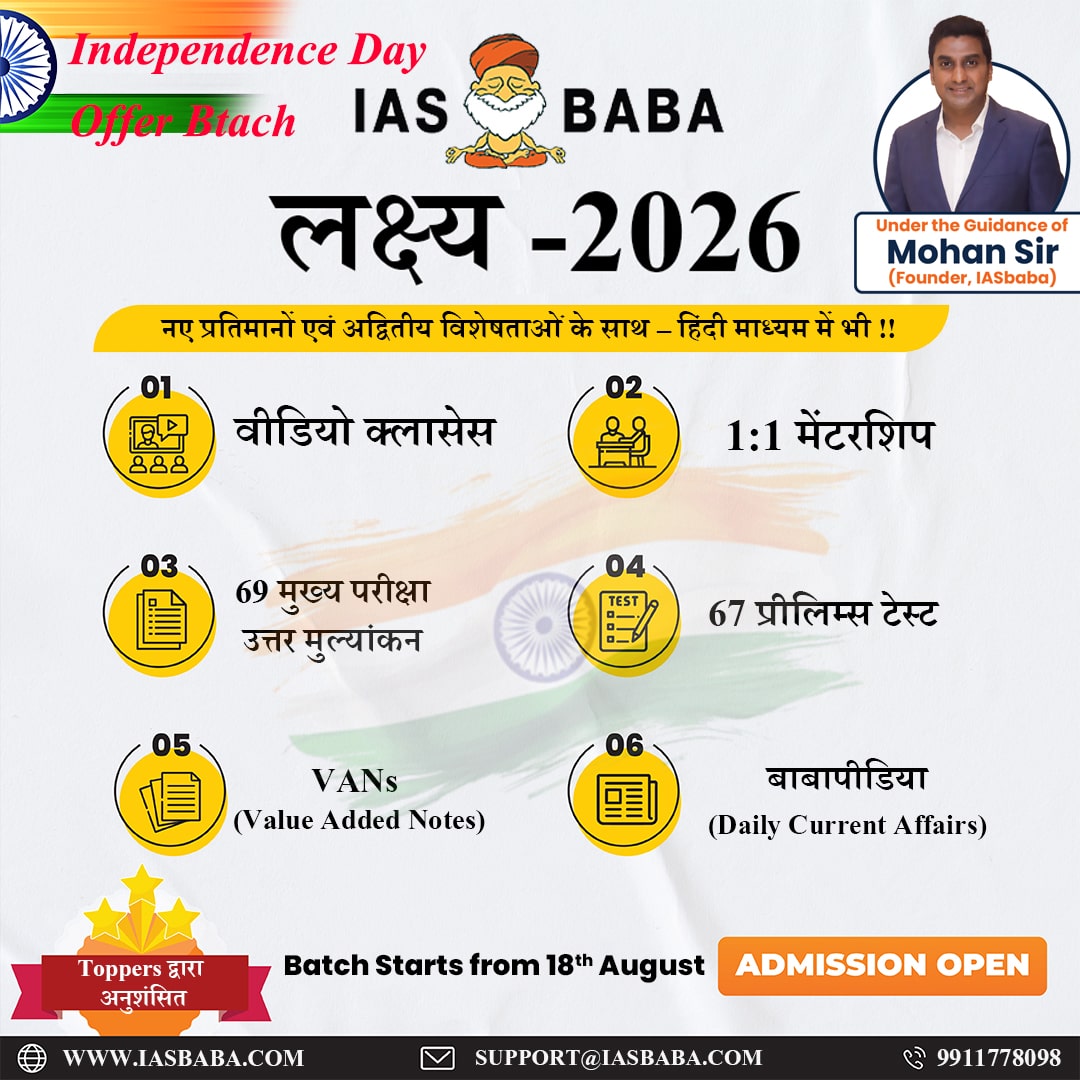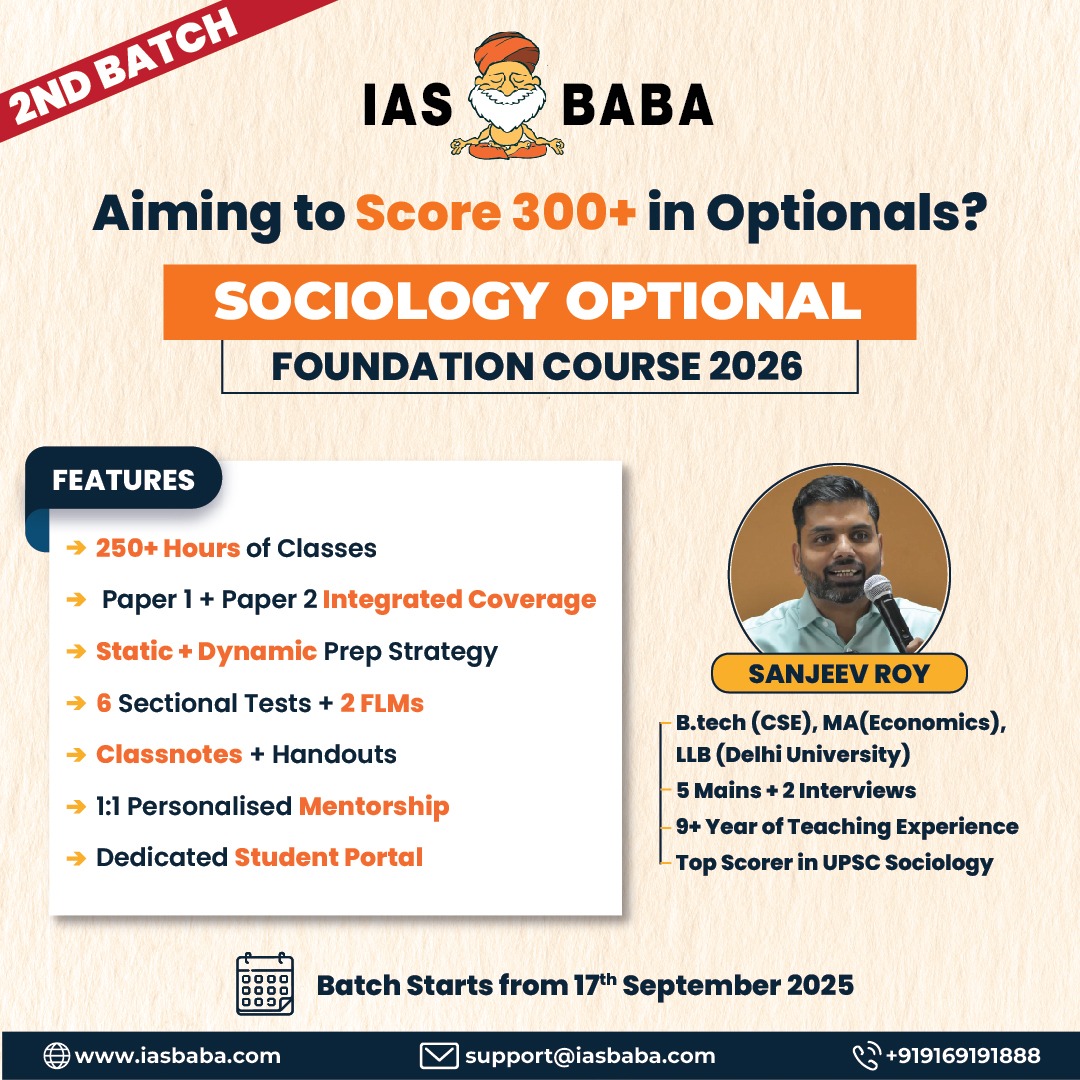IASbaba's Daily Current Affairs Analysis
Archives
(PRELIMS & MAINS Focus)
Category: GOVERNMENT SCHEMES
Context: To ease credit access for startups and fuel innovation in priority sectors, the government has doubled the guarantee cover under its Credit Guarantee Scheme for Startups (CGSS), raising the limit per borrower from ₹10 crore to ₹20 crore.
Decoding the context: The move comes amid tightening funding conditions, with startups calling for stronger institutional support as private capital flows dry up.
Learning Corner:
- The Credit Guarantee Scheme for Startups (CGSS), launched by the Department for Promotion of Industry and Internal Trade (DPIIT) under the Ministry of Commerce and Industry, aims to provide collateral-free debt funding to DPIIT-recognized startups.
- Objective: Facilitates collateral-free loans to startups, reducing lender risk and encouraging debt financing for innovation, aligning with the Viksit Bharat vision.
Key Features of CGSS
| Feature | Details |
| Launched by | DPIIT, Ministry of Commerce & Industry |
| Implemented by | National Credit Guarantee Trustee Company (NCGTC) |
| Target Beneficiaries | DPIIT-recognized startups |
| Type of Guarantee | Collateral-free credit guarantee cover |
| Guarantee Coverage | Up to 75% to 85% of the sanctioned credit |
| Eligible Lenders | Scheduled Commercial Banks, NBFCs, AIFIs, etc. |
| Latest Enhancement (2024-25) | Per borrower guarantee limit raised from ₹10 crore to ₹20 crore |
- Coverage: 85% of the default amount for loans up to ₹10 crore; 75% for loans above ₹10 crore.
- Annual Guarantee Fee (AGF): Reduced to 1% per annum (from 2%) for startups in 27 Champion Sectors under the Make in India initiative. For others, the fee is 2%, with a concessional 1.5% for female entrepreneurs and Northeast startups.
- Implementation: Managed by the National Credit Guarantee Trustee Company (NCGTC), which issues automatic guarantees to Member Institutions (MIs) via its portal upon meeting eligibility criteria.
- Eligible Startups: Must be DPIIT-recognized, not in default, not classified as Non-Performing Assets, and certified by Member Institutions (MIs) as having stable revenue (assessed over 12 months of audited statements).
- Eligible Member Institutions (MIs): Include Scheduled Commercial Banks, NBFCs (BBB-rated, ₹100 crore net worth), and SEBI-registered AIFs.
Source : Livemint
Category: NATIONAL
Context: As per the Sample Registration System (SRS) Report 2021 released by the Registrar General of India (RGI) recently, India has continued to witness a significant improvement in key maternal and child health indicators.
Decoding the context: India’s Progress in reduction of Maternal and Child mortality indicators outpaces Global Averages.
Learning Corner:
- The Sample Registration System (SRS), initiated in 1964-65 and fully operational by 1970, is a large-scale demographic survey conducted by the Office of the Registrar General of India (RGI) under the Ministry of Home Affairs.
- Objective: SRS aims to generate accurate data on births, deaths, and other demographic indicators in the absence of a robust Civil Registration System (CRS), which remains incomplete in India (e.g., only 89% birth registration in 2023, RGI).
- Data Collection:
- Continuous Enumeration: Local part-time enumerators (often teachers) record births and deaths in real-time.
- Independent Half-Yearly Surveys: SRS supervisors conduct retrospective surveys every six months to cross-verify records.
- Matching Process: Events from both methods are matched, with discrepancies resolved through field visits, ensuring data accuracy.
- Outputs: Published in SRS Bulletins (biannual) and detailed annual SRS Statistical Reports.
Key Highlights of the SRS Report
- Maternal Mortality Ratio (MMR) of the country has shown a marked reduction, declining by 37 points from 130 per lakh live births in 2014–16 to 93 in 2019–21.
- The Infant Mortality Rate (IMR) of the country has declined from 39 per 1000 live births in 2014 to 27 per 1000 live births in 2021.
- Neonatal Mortality Rate (NMR) has declined from 26 per 1000 live births in 2014 to 19 per 1000 live births in 2021.
- Under-Five Mortality Rate (U5MR) has declined from 45 per 1000 live births in 2014 to 31 per 1000 live births in 2021.
- The Sex Ratio at Birth improves from 899 in 2014 to 913 in 2021.
- Total Fertility Rate is consistent at 2.0 in 2021, which is a significant improvement from 2.3 in 2014.
Source : PIB
Category: ENVIRONMENT
Context: A study conducted about the offshore breakwater system using geotube technology along the Poonthura coastal stretch (Kerala) has found that they yielded remarkable transformations in the coastal landscape.
Decoding the context: The study, conducted on a 750-meter pilot project initiated in 2019, found that geotubing prevented wave overtopping beyond the seawall—extending protection twice the breakwater’s length on the shore side—and fostered sustainable beach formation even during inclement weather.
Learning Corner:
- Geotubes (also called geotextile tubes) are large, permeable fabric tubes made of high-strength geotextile material.
- They are filled with sand, slurry, or dredged material, and are used primarily for shoreline protection, erosion control, and coastal defense.
- The material allows water to escape while retaining the solids, leading to the formation of a stable, solid structure.
Applications of Geotube Technology
- Coastal Protection:
- Acts as offshore breakwaters or sea walls to reduce wave energy and prevent erosion.
- Commonly used in eroding coastal regions like Kerala, Odisha, West Bengal, and Tamil Nadu.
- Riverbank and Flood Protection: Prevents riverbank erosion and serves as levees or dikes in flood-prone areas.
- Dewatering: Used in industries and sewage treatment plants to dewater sludge.
- Reclamation Projects: Helps in land reclamation by containing dredged material.
Case Study: Poonthura, Kerala
- Context: Poonthura coastal stretch in Kerala was facing severe erosion and damage during monsoons and high tides.
- Intervention: Offshore breakwater system using geotube technology was implemented.
- Outcome:
- Successful reduction in coastal erosion.
- Natural deposition of sand led to beach widening.
- Stabilized the coastline, thus protecting life and property.
Advantages of Geotube Technology
- Cost-effective compared to conventional concrete or rock structures.
- Quick to deploy and requires less maintenance.
- Environmentally friendly — promotes beach nourishment and sediment accumulation.
- Can be easily removed or relocated, offering flexibility.
Source : The Hindu
Category: SCIENCE & TECHNOLOGY
Context: A new case of Nipah virus was confirmed in Kerala in a 42-year-old woman from Malappuram district.
Decoding the context: The Nipah outbreak now reported is the seventh instance in Kerala. The first outbreak was reported in 2018, followed by outbreaks in 2019, 2021, 2023 and 2024. Last year, Kerala reported two Nipah outbreaks. Both outbreaks in 2024 were in Malappuram district.
Learning Corner:
- Nipah Virus is a zoonotic virus (transmitted from animals to humans) belonging to the Paramyxoviridae family, genus Henipavirus.
- It was first identified in 1998–99 in Malaysia among pig farmers.
- In India, major outbreaks occurred in West Bengal (2001, 2007) and Kerala (2018, 2019, 2021, 2023, 2024).
Transmission
- Reservoir Host: Fruit bats of the Pteropus genus (commonly known as flying foxes) are the primary reservoir.
- Transmission can occur:
- Animal to human: Transmission occurs via consumption of contaminated fruits or direct contact with bat secretions.
- Human to human: Close contact with infected persons, especially caregivers.
- Fomites: Contaminated objects and surfaces.
Symptoms
- Incubation period: 4 to 14 days (can extend up to 45 days).
- Symptoms range from asymptomatic to acute respiratory illness and fatal encephalitis.
- Early symptoms: Fever, headache, drowsiness, disorientation.
- Severe cases may result in coma within 24–48 hours.
Fatality & Concerns
- High case fatality rate: Ranges between 40% to 75%.
- No specific treatment or vaccine available.
- Managed through supportive care.
- Classified by WHO as a priority disease for research due to epidemic potential.
Source : The Hindu
Category: ENVIRONMENT
Context: Three wild elephants were found dead in the Manas National Park in Assam near the India-Bhutan border.
Decoding the context: It is suspected that poachers have killed the elephants.
Learning Corner:
- Manas National Park, located in Assam, India, spans the districts of Baksa, Chirang, and Bongaigaon, along the foothills of the Eastern Himalayas.
- Named after the Manas River—a major tributary of the Brahmaputra—it was declared a national park in 1990 and is a UNESCO World Heritage Site (designated in 1985), a Project Tiger Reserve and an Elephant Reserve.
- Area: Approx. 950 sq. km (core area); it forms part of a larger biosphere reserve.
- Linked to the Royal Manas National Park of Bhutan, forming a transboundary conservation area.
Geographical and Ecological Significance
- Location and Terrain: Situated at the confluence of the Indian, Indo-Malayan, and Indo-Chinese biogeographical realms, Manas features a diverse landscape of grasslands, tropical semi-evergreen forests, and alluvial floodplains.
- It lies at an elevation of 61-110 meters above sea level, with the Manas River flowing through it, shaping its flood-dependent ecology.
- Biodiversity:
- Flora: Over 840 plant species, including rare orchids and tropical Sal forests. Grasslands dominate 45% of the park, supporting herbivore populations.
- Fauna: Hosts 55 mammal species, 450 bird species, 50 reptile species, and 3 amphibian species. Key species include:
- Endangered Mammals: Bengal tiger, Indian elephant, greater one-horned rhinoceros, pygmy hog, and hispid hare.
- Birds: Bengal florican, great hornbill, and migratory species like the red-headed vulture.
- Cultural Significance: The park is sacred to the Bodo community, who revere the Manas River. The annual Manas Festival, held in April (last held April 5-7, 2025), promotes eco-tourism and Bodo culture.
Conservation Challenges
- Poaching and Insurgency: During the Bodo insurgency (1980s-2000s), Manas faced severe poaching, particularly of rhinos. Militants used the park as a hideout, disrupting conservation efforts.
- UNESCO listed Manas as a World Heritage Site in Danger from 1992 to 2011 due to habitat destruction and wildlife loss.
- UNESCO Status Restored: Removed from the “in danger” list in 2011 after improved conservation measures.
Source : The Hindu
Practice MCQs
Q1. Why is May 11 celebrated as National Technology Day in India?
A. To commemorate the establishment of DRDO.
B. To celebrate India’s first satellite launch.
C. To mark India’s successful nuclear tests under Operation Shakti in 1998.
D. To recognize the formation of the Department of Science and Technology (DST).
Q2. Which of the following statements regarding methane is/are correct?
- Methane has a higher Global Warming Potential (GWP) than carbon dioxide over a 100-year period.
- Methane has a longer atmospheric lifespan than carbon dioxide.
- Methane contributes to the formation of ground-level ozone.
A. 1 and 3 only
B. 2 and 3 only
C. 1 and 2 only
D. 1, 2 and 3
Q3. Consider the following statements regarding the Nipah Virus (NiV):
- It is caused by a bacterium belonging to the genus Henipavirus.
- Fruit bats of the Pteropus genus are the natural reservoir of the virus.
- India has witnessed outbreaks of Nipah Virus only in Kerala.
- There is currently no approved vaccine or specific treatment for Nipah Virus infection.
Which of the statements given above is/are correct?
A) 1 and 2 only
B) 2, 3, and 4 only
C) 2 and 4 only
D) 1, 2, and 4 only
Comment the answers to the above questions in the comment section below!!
ANSWERS FOR ’ Today’s – Daily Practice MCQs’ will be updated along with tomorrow’s Daily Current Affairs
ANSWERS FOR 10th May – Daily Practice MCQs
Q.1) – b
Q.2) – a
Q.3) – b

